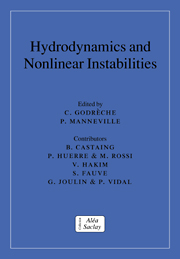Book contents
- Frontmatter
- Contents
- Preface
- Contributors
- Overview
- 1 An introduction to hydrodynamics
- 2 Hydrodynamic instabilities in open flows
- 3 Asymptotic techniques in nonlinear problems: some illustrative examples
- 4 Pattern forming instabilities
- 5 An introduction to the instability of flames, shocks, and detonations
- Index
4 - Pattern forming instabilities
Published online by Cambridge University Press: 04 November 2009
- Frontmatter
- Contents
- Preface
- Contributors
- Overview
- 1 An introduction to hydrodynamics
- 2 Hydrodynamic instabilities in open flows
- 3 Asymptotic techniques in nonlinear problems: some illustrative examples
- 4 Pattern forming instabilities
- 5 An introduction to the instability of flames, shocks, and detonations
- Index
Summary
Introduction
Instabilities in nonlinear systems driven far from equilibrium often consist of a transition from a motionless state to one varying periodically in space or time. Various examples, widely studied in the past, are Rayleigh – Bénard convection, Couette–Taylor flow, waves in shear flows, instabilities of liquid crystals, oscillatory chemical reactions,…. The appearance of periodic structures in these systems driven externally by a forcing homogeneous in space or constant in time, corresponds to a bifurcation, characterized by one or several modes that become unstable as a control parameter is varied. Linear stability analysis of the basic state gives the critical value of the control parameter for the primary instability onset, the nature of the most unstable modes and their growth rate above criticality. Many examples have been studied for a long time and can be found for instance in the books of Chandrasekhar (1961) or Drazin and Reid (1981). However, linear stability analysis does not describe the saturation mechanism of the primary instability, and thus a nonlinear analysis should be performed to determine the selected pattern, its dynamics and in particular the secondary instabilities that occur as the control parameter is increased above criticality. Before considering these problems, we present some examples of the characteristic phenomena that occur above a pattern-forming instability onset.
Example: the Faraday instability
As a first example, consider a cylindrical vessel containing a liquid and its vapor (or any other gas), vertically vibrated at frequency ωe (see Fig. 1.1).
- Type
- Chapter
- Information
- Hydrodynamics and Nonlinear Instabilities , pp. 387 - 492Publisher: Cambridge University PressPrint publication year: 1998
- 21
- Cited by



